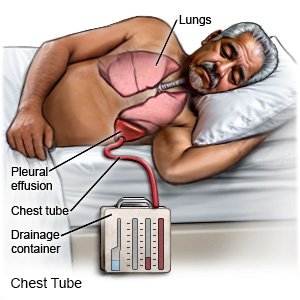Chest Tubes
Medically reviewed by Drugs.com. Last updated on Apr 6, 2025.
A chest tube is a plastic tube that is put through the side of your chest. A suction device removes air, blood, or fluid from around your heart or lung. This will help you breathe more easily. A chest tube is also known as chest drain or chest drainage tube.
 |
DISCHARGE INSTRUCTIONS:
Call your local emergency number (911 in the US) if:
- You suddenly feel lightheaded and have shortness of breath.
- You have chest pain. You may have more pain when you take a deep breath or cough.
- You cough up blood.
Seek care immediately if:
- Blood or fluid soaks through your bandage.
- Your chest tube comes out.
- Your arm or leg feels warm, tender, and painful. It may look swollen and red.
Call your doctor if:
- You have a fever.
- You have severe pain and swelling at the insertion site.
- Your insertion site is red, draining pus, or has a bad smell coming from it.
- You have questions or concerns about your condition or care.
Drugs used to treat this and similar conditions
Zoladex
Zoladex (goserelin) is used to treat endometriosis and breast cancer in women and prostate cancer ...
Azithromycin Dose Pack
Azithromycin Dose Pack is used for babesiosis, bacterial endocarditis prevention, bacterial ...
Ozempic
Learn about Ozempic (semaglutide) for type 2 diabetes treatment, weight management, cardiovascular ...
Vibramycin
Vibramycin is used for acne, actinomycosis, amebiasis, anthrax, anthrax prophylaxis, bacterial ...
Amoxicillin/clavulanate
Amoxicillin and clavulanate potassium is a combination antibiotic used to treat bacterial ...
Cefdinir
Cefdinir systemic is used for bacterial infection, bronchitis, middle ear infections, pneumonia ...
Amoxicillin
Amoxicillin is a penicillin antibiotic that fights bacteria. It is used to treat many types of ...
Cyklokapron
Cyklokapron is used for bleeding disorder, factor ix deficiency, hemophilia a
Azithromycin
Azithromycin is an antibiotic used to treat many different types of infections caused by bacteria ...
Ceftriaxone
Ceftriaxone systemic is used for bacteremia, bacterial endocarditis prevention, bacterial ...
Medicines:
You may need any of the following:
- Antibiotics help prevent or fight an infection caused by bacteria.
- Prescription pain medicine may be given. Ask your healthcare provider how to take this medicine safely. Some prescription pain medicines contain acetaminophen. Do not take other medicines that contain acetaminophen without talking to your healthcare provider. Too much acetaminophen may cause liver damage. Prescription pain medicine may cause constipation. Ask your healthcare provider how to prevent or treat constipation.
- Take your medicine as directed. Contact your healthcare provider if you think your medicine is not helping or if you have side effects. Tell your provider if you are allergic to any medicine. Keep a list of the medicines, vitamins, and herbs you take. Include the amounts, and when and why you take them. Bring the list or the pill bottles to follow-up visits. Carry your medicine list with you in case of an emergency.
Self-care:
- Find a comfortable position. You may have pain or discomfort while the chest tube is in. Lie in a different position to help decrease your pain.
- Cough and breathe deeply as directed. This will decrease your risk for a lung infection. Take deep breaths and cough 10 times each hour. Hold a pillow tightly against your insertion site when you cough. Take a deep breath and hold it for as long as your can. Then let the air out and cough strongly.
Care for your chest tube:
- Check your chest tube for kinks or loops. Keep the tube close to you when you are in bed, but do not lie on it. Do not let loops of tubing hang down the side of your bed. Be sure your tubing is long enough so that you can move and turn in bed without pulling on it. Never clamp the tube yourself.
- Keep the suction device below the level of your chest. This will help fluids drain from your chest to the container below. This will also help prevent fluids from flowing back into your chest.
- Make sure your chest tube is secure. Make sure your chest tube is securely taped to your body. Your chest tube may also be taped to the suction device to help prevent the tubes from coming apart.
- Do not turn knobs or change settings on your device unless a healthcare provider tells you to. If your suction device has water in it, the water should bubble gently, with short periods of no bubbling. A lot of bubbling that does not stop may mean air is leaking.
Care for the insertion site as directed:
Keep your bandage clean and dry. Ask your healthcare provider when you can bathe.
Follow up with your doctor as directed:
Write down your questions so you remember to ask them during your visits.
© Copyright Merative 2025 Information is for End User's use only and may not be sold, redistributed or otherwise used for commercial purposes.
The above information is an educational aid only. It is not intended as medical advice for individual conditions or treatments. Talk to your doctor, nurse or pharmacist before following any medical regimen to see if it is safe and effective for you.
Further information
Always consult your healthcare provider to ensure the information displayed on this page applies to your personal circumstances.
